Samsung
Samsung Galaxy A71: a successful 6.7-inch smartphone
Aprox. 364€ - see price -
See specificationsThe Samsung Galaxy A71 is a smartphone with a very large screen (6.7 inches), an ultra-defined main photo sensor, all coated with know-how and ergonomics "made in Korea". What to make it a must?
Our review
Presentation
The third Samsung mobile launched here this year, the Galaxy A71 could be considered a lighter version of the all-new Galaxy Note 10 Lite.
Samsung thus offers a phablet (6.7 inch screen!) At less than € 500 which allows it to stand out from the "high-end killers" that abound in this price range, such as the Xiaomi Mi 9T Pro, the Honor 20 Pro, the Oppo Reno 2, and of course the Xiaomi Mi Note 10.
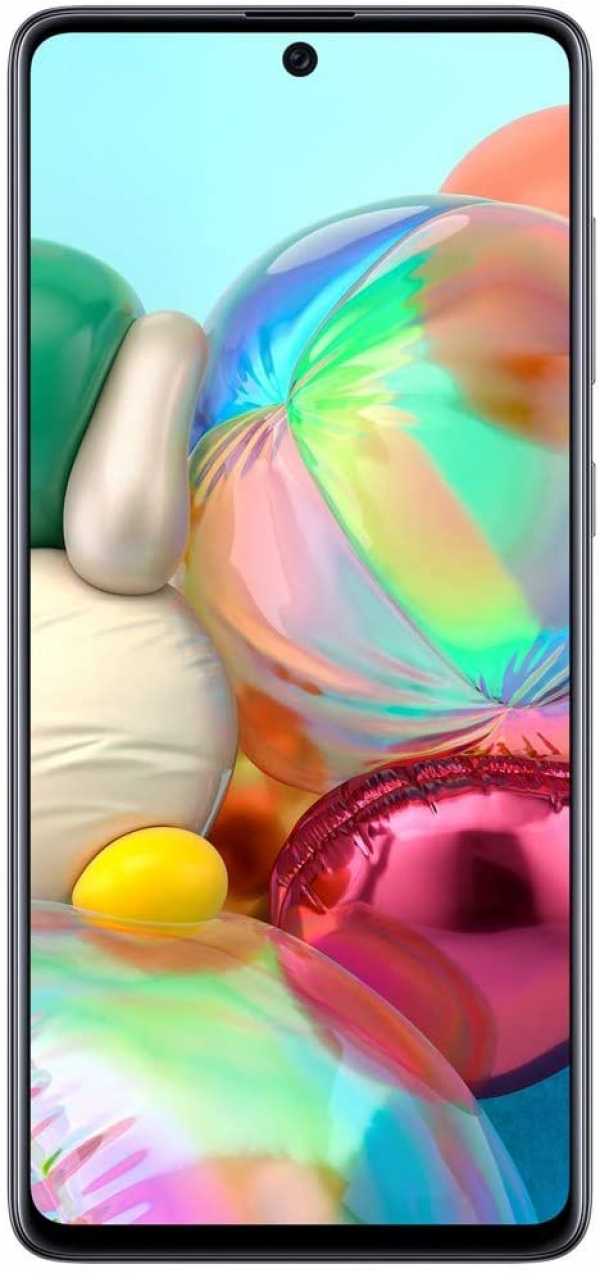
Ergonomics and design
Samsung seems to have extended the design of its A51 to obtain the A71. He thus retrieves this large 6.7-inch panel, called Infinity-O, recognizable by its small central punch which houses the selfie module. This format allows the screen to occupy more than 87.5% of the front panel. Despite the absence of curved edges, you almost have the feeling of having only one slab in your hands. Guaranteed effect!
As often, the unlocking of the mobile can go through an optical fingerprint sensor placed under the screen. A solution which, despite a few hiccups here and there, improves with each new generation. On the back of the device, there is a photo block - now classic at Samsung - housing four photo modules and the flash. Although all plastic, the smartphone has good finishes, like these dorsal ridges which cause pretty light effects. We can still regret the absence of glass or metal to cover the mobile. In this price zone, some manufacturers offer more noble materials.
Although quite long, the A71 is not very heavy (179 g) and its pleasant use ... provided that you agree to use both hands. Regarding the connections, the A71 has two slots for nanoSIM cards and one for a microSD memory card that will allow you to expand the 128 GB of internal memory. It is also equipped with a USB-C port and a 3.5 mm mini-jack plug. Note that it is not waterproof or compatible with induction charging.
At first measurements, the headphone jack of this A71 seems more than adequate. It delivers a sound powerful enough to power the most energy-consuming headsets. The dynamic range is wide and the stereo reproduction is almost standard. Too much distortion, however, affects the quality of the audio signal.
The single speaker located on the lower edge delivers sound of acceptable quality. However, beyond 60 to 70% of the maximum volume, the sound begins to saturate. To be used only as an auxiliary solution therefore.
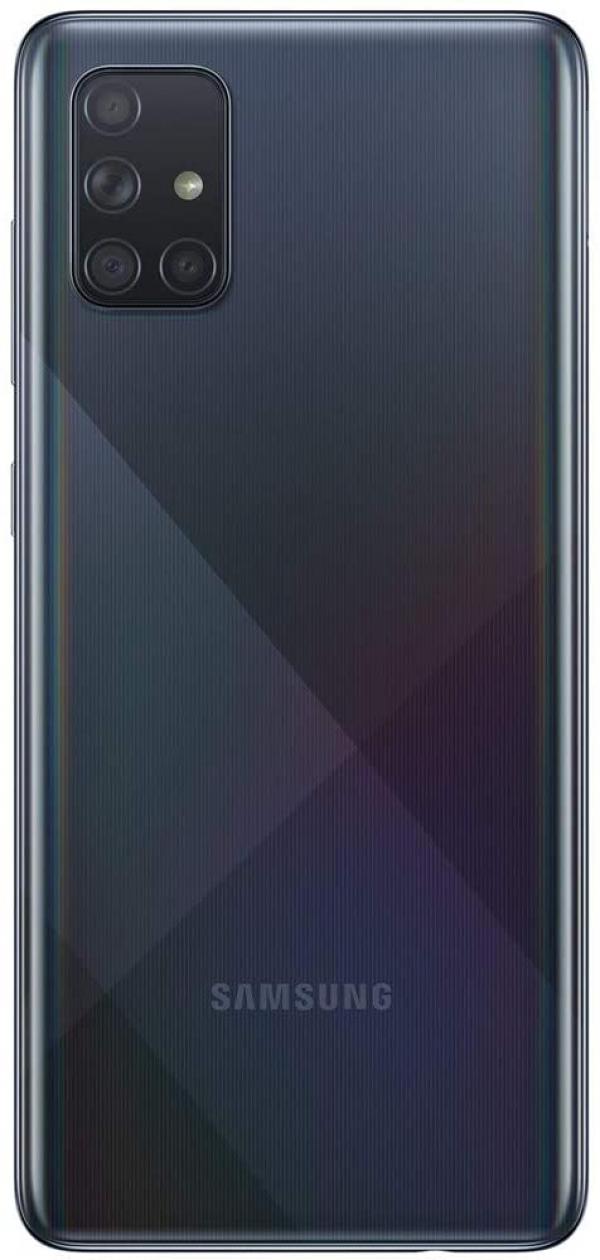
Screen
Like the Galaxy Note 10 Lite, the Galaxy A71 is equipped with a 6.7-inch Amoled panel with a definition of 2,400 x 1,080 pixels (for a resolution of 393 ppi), all at a ratio of 20: 9. Not surprisingly, there are similarities between the two screens. Strength of the Oled, the contrast is almost infinite. The color reproduction is very faithful; as proof, we measured a Delta E at 1.9 (less than 3, and therefore at the threshold of perception of the human eye). As for the color temperature measured at 6,687 K, it is almost at the level of the video standard (6,500 K).
For the rest, with a well controlled reflectance (45%), infinite contrast and good maximum brightness (544 cd / m²), use in full sun should not be a problem. When the light comes down, the minimum brightness of 1.9 cd / m² will be very useful so as not to damage your eyes. Finally, still thanks to Oled technology, the afterglow is imperceptible and we evaluated the tactile delay at 60 ms, making the terminal display very fluid.
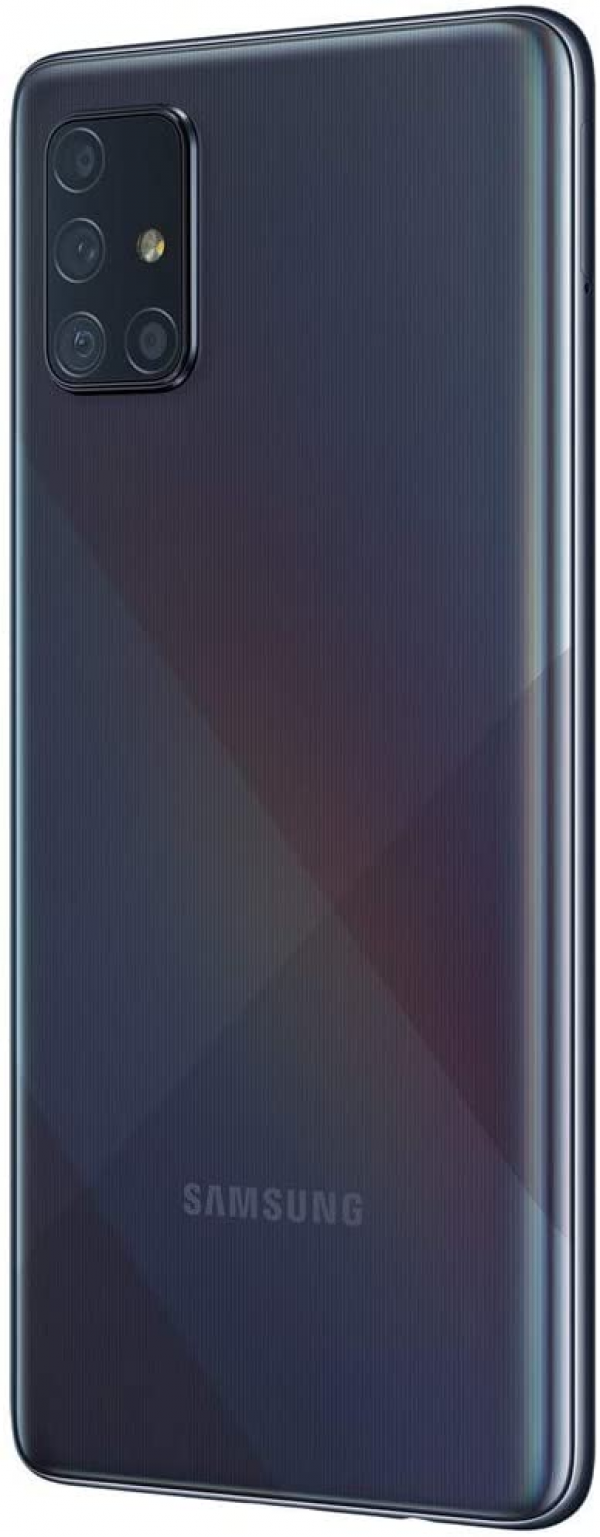
Performances
The Galaxy A71 derives its computing power from an 8-core processor, the Qualcomm Snapdragon 730, accompanied by 6 GB of RAM. The graphics part is provided by an Adreno 618 GPU. This configuration was already in place on the manufacturer's Galaxy A80 released in spring 2019, except that the latter had 8 GB of RAM. During the multitasking test, this A71 proved to be really efficient. With 96.38 points, it does better than all the Samsung smartphones in our comparison, even the most high-end, like the Galaxy Note 10+ and the Galaxy Fold.
When our game simulator finished, the soufflé dropped a little. The score of just 53.70 points is the worst of the Snapdragon 730 smartphones we tested. On average, the A71 barely exceeds 30 fps in game, under the minimum rate necessary to play smoothly. For comparison, the Xiaomi Mi 9T, with a similar configuration, maintains without worry more than 40 fps.
Our performance tests are carried out with viSer, the application developed by the company SmartViser.
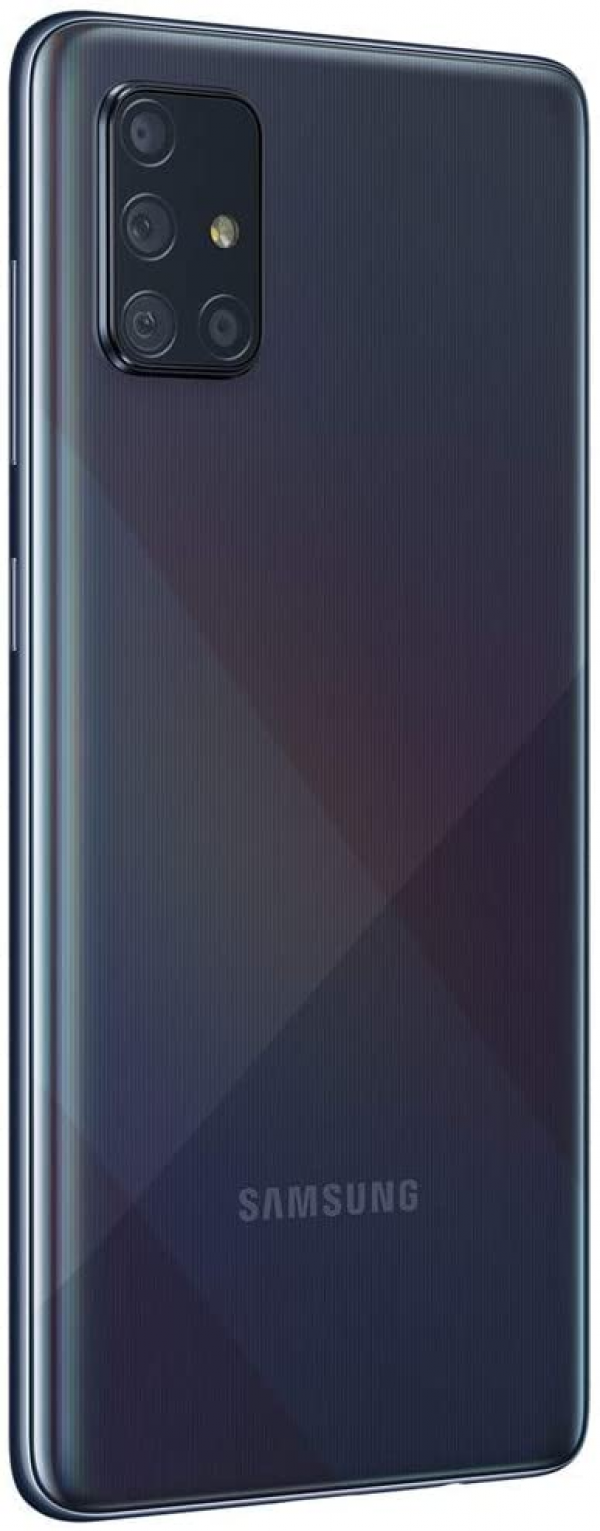
Photo
The Samsung Galaxy A71 uses the same optical unit with 4 sensors as the A51. The only notable difference concerns the main sensor which goes to 64 megapixels and opens at f / 1.8 (against f / 2 for the A51). Apart from the A70s, which had not been released in Spain, the A71 is, for the moment, the only Samsung smartphone with such a sensor.
The ISOCEL GW1 64 Mpx sensor uses pixel binning and therefore assembles 4 pixels in 1 to improve the quality of the shots, especially in low light. By default, the sensor then produces 16 megapixel photos.
In broad daylight, the A71 comes out of it honorably, with a remarkable dive, limited optical aberrations and a very correct level of detail. However, the photo is not natural enough and clearly turns red; we can recognize Samsung's leg here. Opposite, the very good Xiaomi Mi Note 10 offers a more natural result with better controlled colorimetry and less forced contrasts.
The A71 is more trouble when the light runs out. Despite a high definition sensor and the use of the binning pixel, the mobile does not compare with the Mi Note 10. The image seems a little underexposed and the strong smoothing almost suggests that a layer of grease covers the 'goal. Finally, the level of details is not good enough, especially with regard to what the Mi Note 10 provides. The sharpness of the Chinese mobile is so much higher that the photo of the A71 seems blurred. This result in low light is a real disappointment.
Ultra wide-angle modules rarely produce flattering results, especially when we look at the shots at 100%. The A71 is no exception. The shot lacks sharpness and the barrel distortions are very marked. The fish-eye effect is then quite pronounced on this 12 mm equivalent in 24x36. Opposite, the Xiaomi, thanks to a more defined sensor, more successful software processing and an optic bringing less distortions, offers a much sharper and more detailed image.
Under 3 lux lighting, the UGA module displays its limits a little more. In addition to all the defects already mentioned, there is an excessive smoothing which removes any realistic aspect from the photo, even if most of the details of the scene are identifiable. However, we could not be too harsh on this Samsung, because rare are the devices to produce an ideal result in these conditions.
For the video part, the Samsung Galaxy A71 is capable of recording up to 4K at 30 fps. Note that it can also capture sequences in 240 fps or 960 fps in Full HD. We somewhat regret the absence of optical stabilization. Only digital stabilization is present, and it does not work in 4K or in low light.
At the front, it's a 32-megapixel sensor that acts as a selfie machine. It is equipped with a lens equivalent to 26 mm and opening at f / 2.2. The level of details is quite good, but the smoothing of the faces activated by default is a little too strong and we advise to deactivate it (except personal preferences).
The macro module of 5 MP can be useful to capture the details of an object or a flower. However, as often with this kind of smartphone system, the shadow of the mobile associated with the short focal length of the lens means that you cannot get as close as you would like to achieve a good macro shot.
Finally, the portrait mode is quite convincing, the clipping is well done and the background blur rather natural.
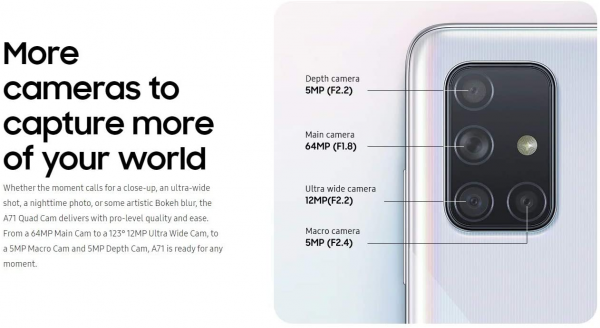
Autonomy
To power its Galaxy A71, Samsung has chosen to install an accumulator with a capacity of 4,500 mAh. According to our endurance protocol, the mobile turned off after 5:11 pm A very correct autonomy which allows it to hang the fifth star, but which remains well below that of the Galaxy A70. Last year, with an equivalent battery, it lasted 22 h 49 min.
With the 25 W "super fast" charger delivered from the factory, the phone took 1 h 14 min to fully charge.
Our battery tests are automated by viSer, the application developed by the company SmartViser. The results obtained with viSer come from measurements carried out under real conditions of use (calls, SMS, videos, launching of applications, web browsing, etc.).
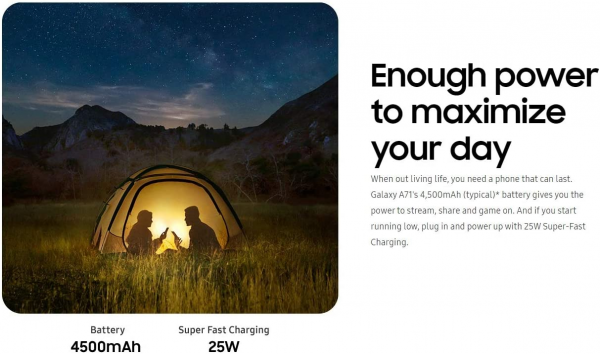
Conclusion
The Galaxy A71 is a good big screen smartphone for those who don't want to spend too much. Nevertheless, past this beautiful screen, we remain skeptical in front of its plastic finishes or its autonomy, certainly good, but which we expected better, or even this underused photo section. After this test, it almost seems that Samsung has not done everything to tweak its phone. Opposite, the Oppo Reno2, the Honor 20 Pro, a Xiaomi Mi 9T Pro and especially the Xiaomi Mi Note 10 seem to be more relevant choices.
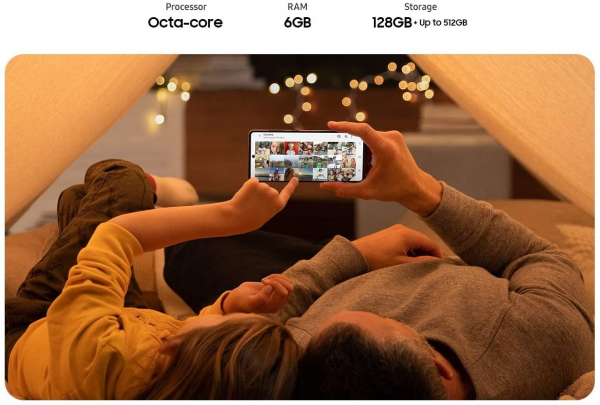
Specifications
Reviews

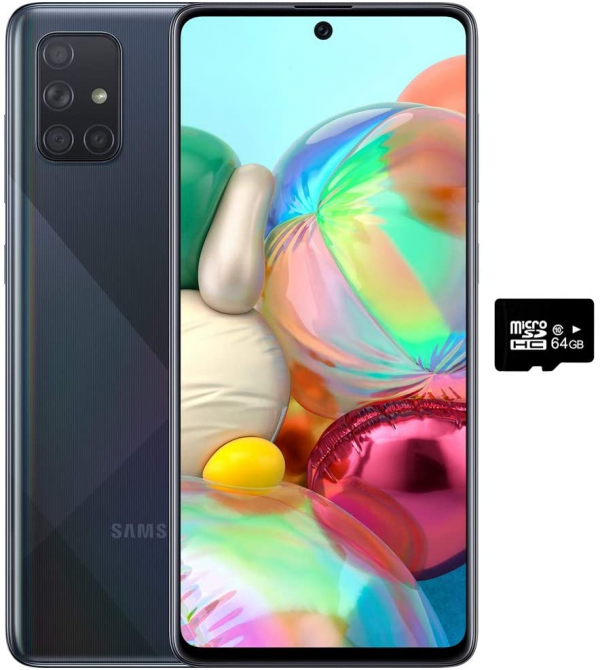
Great Phone!
After looking at many phones to replace my old Samsung Galaxy Note 3 which was becoming problematic, I decided on this one. Even though it wasn't like the Samsung Galaxy Note 10+, which my wife got for Christmas from Verizon which had a great deal going on, this phone to me was also a great deal because I only paid $ 355 for it. I have T-Mobile service and this phone works perfectly with my carrier. The description was accurate for it also. Plenty of internal memory 128gb, I have a 64gb micro sim in it, it's also running Android 10. So far, so good! Big display, and I'm getting used to all the features that it offers. Nice camera also with lots of options. Battery life is one of the best features of this phone. 4500mAh, enough for the whole day and then some. I haven't used the face recognition or the fingerprint reader yet, but don't expect any problems with those anyway. Seems like I made the right choice! There's nothing wrong with getting an international phone either. You shouldn't be stuck having to get a phone from one of the US carriers, that limit your selection, and has you paying higher prices. Even though this phone is Samsung's mid level "a" series, your saving a bunch of money and in my opinion, won't even notice any differences. The only problem that I had, however, was that when I received the phone the shipping box wasn't packed properly and when I opened the box, the phone was laying outside of it's box and so were most of the accessories that it came with ! I immediately contacted Amazon, and the customer rep fully understood my concern, and told me that for any reason I could return it within 1 month for a full refund. But in conclusion, I set it up, it works fine and I'm having a good time with it. Enjoy !! I read some of the other reviews posted, and can't believe what some people have said. One review said that the phone is not 4G, it definitely is. Even if it doesn't show a "4G" icon on top, it is. Mine says LTE or LTE +. If you google it, that is 4G. In another review, the person mentioned that the battery only lasts half a day and gets very hot. My phone lasts for about a day in a half and I have no issue with excessive heat. Again, for less than $ 400, you can't go wrong.
Almost perfect phone.
At the time when I was looking to buy this phone, there wasn't a lot of reviews for this phone except for the Samsung a51 (the little brother) and YouTube channels that got early access to this phone. Most all channels mention how the material, glastic, on the back of this mid tier phone felt cheap and wasn't on par with the usual metal to glass build on flagship phones. I would have to disagree. To me it felt fine and even feels better to hold in my hand. YouTube channels also mention how big this thing is and because of that it was too bulky and big for comfort. To me (a small Filipino) the size of this phone wasn't terrible to hold at all. I can handle the weight with ease without any discomfort even if I'm on it for long periods of time. It really isn't that heavy. As for navigating the phone, I had to learn that I won't be able to do one-handed on this beast. I don't do one-handed operations on mobile devices, most of the time, anyway. But watching movies or shows with one hand is no problem. I was worried because when I first took a look it this thing, it was longer than most all phones I've seen as of yet, an exception to Sony's newer flagship devices.
The 'punch hole' or so they called it is at a better location than the previous iterations of the Samsung Galaxy series (S10, S10 Plus, S10e). The cameras on the back are protruding so laying it flat on a surface, camera down, is a big discouragement if you don't plan on putting a case on it. As for quality it's a much better camera than my previous Samsung Galaxy Halo. And it's on by if not better than the iPhone X especially in low lighting. Selfie camera is super great but it doesn't do well in lower lighting.
Overall, I really do love this phone. It's body to screen ratio is one of the best I've seen in the market (especially when it has the hole punch display). The bezels are barely there. The screen is great but could be brighter during sunny days. The Samsung Galaxy a71 is light weight and is packed full of features (like NFC so you can pay with your phone) and not to mention its 400 $, half the price of a flagship phone that has these features. So if you are looking for a budget phone packed full of features and don't mind it being 'glastic' then this is a phone for you!
Love love love!
So far, so great! I am in love with the A71 !! The screen is awesome, it charges super fast and the battery life is superb! The camera takes great pics and the call quality is perfect. I posted some photos that I have taken to show the quality.